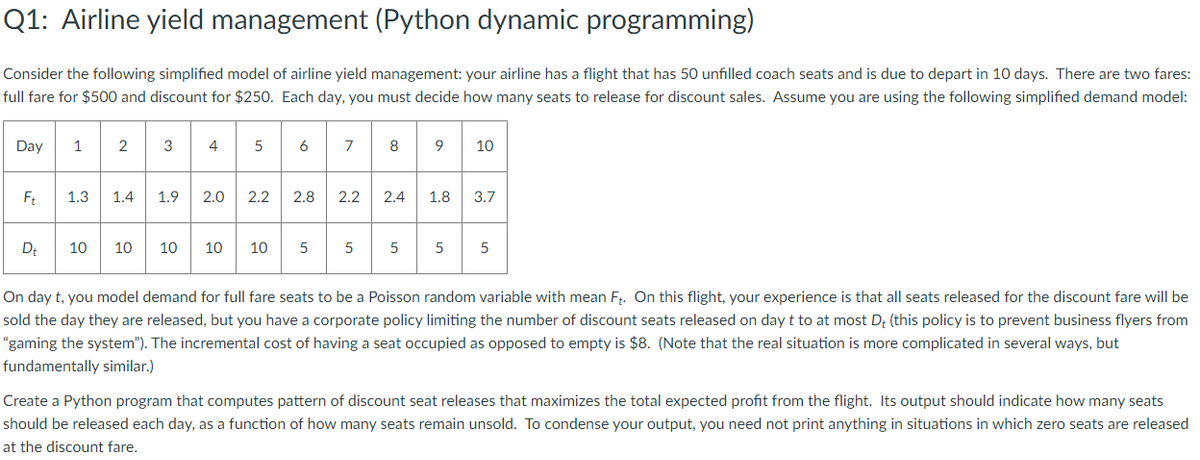Q1: Airline yield management (Python dynamic programming) Consider the following simplified model of airline yield management: your airline has a flight that has 50 unfilled coach seats and is due to depart in 10 days. There are two fares full fare for $500 and discount for $250. Each day, you must decide how many seats to release for discount sales. Assume you are using the following simplified demand model: Day 1 2 3 4 5 6 7 8 9 10 Ft 1.3 1.4 1.9 2.0 2.2 2.8 2.2 2.4 1.8 3.7 Dt 10 10 10 10 10 5 5 5 5 5 On day t, you model demand for full fare seats to be a Poisson random variable with mean Ft. On this flight, your experience is that all seats released for the discount fare will be sold the day they are released, but you have a corporate policy limiting the number of discount seats released on day t to at most D+ (this policy is to prevent business flyers from "gaming the system"). The incremental cost of having a seat occupied as opposed to empty is $8. (Note that the real situation is more complicated in several ways, but fundamentally similar.) Create a Python program that computes pattern of discount seat releases that maximizes the total expected profit from the flight. Its output should indicate how many seats should be released each day, as a function of how many seats remain unsold. To condense your output, you need not print anything in situations in which zero seats are released at the discount fare.
Q1: Airline yield management (Python dynamic programming) Consider the following simplified model of airline yield management: your airline has a flight that has 50 unfilled coach seats and is due to depart in 10 days. There are two fares full fare for $500 and discount for $250. Each day, you must decide how many seats to release for discount sales. Assume you are using the following simplified demand model: Day 1 2 3 4 5 6 7 8 9 10 Ft 1.3 1.4 1.9 2.0 2.2 2.8 2.2 2.4 1.8 3.7 Dt 10 10 10 10 10 5 5 5 5 5 On day t, you model demand for full fare seats to be a Poisson random variable with mean Ft. On this flight, your experience is that all seats released for the discount fare will be sold the day they are released, but you have a corporate policy limiting the number of discount seats released on day t to at most D+ (this policy is to prevent business flyers from "gaming the system"). The incremental cost of having a seat occupied as opposed to empty is $8. (Note that the real situation is more complicated in several ways, but fundamentally similar.) Create a Python program that computes pattern of discount seat releases that maximizes the total expected profit from the flight. Its output should indicate how many seats should be released each day, as a function of how many seats remain unsold. To condense your output, you need not print anything in situations in which zero seats are released at the discount fare.
C++ Programming: From Problem Analysis to Program Design
8th Edition
ISBN:9781337102087
Author:D. S. Malik
Publisher:D. S. Malik
Chapter5: Control Structures Ii (repetition)
Section: Chapter Questions
Problem 20PE: When you borrow money to buy a house, a car, or for some other purpose, you repay the loan by making...
Related questions
Question
Alert dont submit

Transcribed Image Text:Q1: Airline yield management (Python dynamic programming)
Consider the following simplified model of airline yield management: your airline has a flight that has 50 unfilled coach seats and is due to depart in 10 days. There are two fares:
full fare for $500 and discount for $250. Each day, you must decide how many seats to release for discount sales. Assume you are using the following simplified demand model:
Day
1
2
3
4
5
6
7
8
9
10
Ft
1.3 1.4 1.9 2.0
2.2
2.8 2.2
2.4
1.8
3.7
Dt
10
10
10 10
10
5
5
5
5
5
On day t, you model demand for full fare seats to be a Poisson random variable with mean Ft. On this flight, your experience is that all seats released for the discount fare will be
sold the day they are released, but you have a corporate policy limiting the number of discount seats released on day t to at most D+ (this policy is to prevent business flyers from
"gaming the system"). The incremental cost of having a seat occupied as opposed to empty is $8. (Note that the real situation is more complicated in several ways, but
fundamentally similar.)
Create a Python program that computes pattern of discount seat releases that maximizes the total expected profit from the flight. Its output should indicate how many seats
should be released each day, as a function of how many seats remain unsold. To condense your output, you need not print anything in situations in which zero seats are released
at the discount fare.
Expert Solution
This question has been solved!
Explore an expertly crafted, step-by-step solution for a thorough understanding of key concepts.
This is a popular solution!
Trending now
This is a popular solution!
Step by step
Solved in 4 steps with 2 images

Knowledge Booster
Learn more about
Need a deep-dive on the concept behind this application? Look no further. Learn more about this topic, computer-science and related others by exploring similar questions and additional content below.Recommended textbooks for you

C++ Programming: From Problem Analysis to Program…
Computer Science
ISBN:
9781337102087
Author:
D. S. Malik
Publisher:
Cengage Learning

C++ for Engineers and Scientists
Computer Science
ISBN:
9781133187844
Author:
Bronson, Gary J.
Publisher:
Course Technology Ptr

C++ Programming: From Problem Analysis to Program…
Computer Science
ISBN:
9781337102087
Author:
D. S. Malik
Publisher:
Cengage Learning

C++ for Engineers and Scientists
Computer Science
ISBN:
9781133187844
Author:
Bronson, Gary J.
Publisher:
Course Technology Ptr